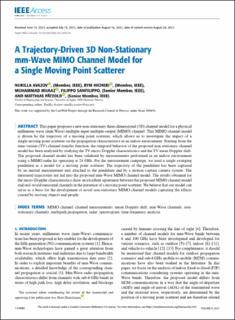| dc.contributor.author | Avazov, Nurilla | |
| dc.contributor.author | Hicheri, Rym | |
| dc.contributor.author | Muaaz, Muhammad | |
| dc.contributor.author | Sanfilippo, Filippo | |
| dc.contributor.author | Pätzold, Matthias Uwe | |
| dc.date.accessioned | 2023-06-29T07:19:31Z | |
| dc.date.available | 2023-06-29T07:19:31Z | |
| dc.date.created | 2021-08-23T12:49:19Z | |
| dc.date.issued | 2021 | |
| dc.identifier.citation | Avazov, N., Hicheri, R., Muaaz, M., Sanfilippo, F. & Pätzold, M. U. (2021). A Trajectory-Driven 3D Non-Stationary mm-Wave MIMO Channel Model for a Single Moving Point Scatterer. IEEE Access, 9, 115990-116001. doi: | en_US |
| dc.identifier.issn | 2169-3536 | |
| dc.identifier.uri | https://hdl.handle.net/11250/3074263 | |
| dc.description.abstract | This paper proposes a new non-stationary three-dimensional (3D) channel model for a physical millimeter wave (mm-Wave) multiple-input multiple-output (MIMO) channel. This MIMO channel model is driven by the trajectory of a moving point scatterer, which allows us to investigate the impact of a single moving point scatterer on the propagation characteristics in an indoor environment. Starting from the time-variant (TV) channel transfer function, the temporal behavior of the proposed non-stationary channel model has been analyzed by studying the TV micro-Doppler characteristics and the TV mean Doppler shift. The proposed channel model has been validated by measurements performed in an indoor environment using a MIMO radar kit operating at 24 GHz. For the measurement campaign, we used a single swinging pendulum as a model for a moving point scatterer. The trajectory of the pendulum has been captured by an inertial measurement unit attached to the pendulum and by a motion capture camera system. The measured trajectories are fed into the proposed mm-Wave MIMO channel model. The results obtained for the micro-Doppler characteristics show an excellent agreement between the proposed MIMO channel model and real-world measured channels in the presence of a moving point scatterer. We believe that our model can serve as a basis for the development of novel non-stationary MIMO channel models capturing the effects caused by moving objects and people. | en_US |
| dc.language.iso | eng | en_US |
| dc.publisher | IEEE (Institute of Electrical and Electronics Engineers) | en_US |
| dc.rights | Navngivelse 4.0 Internasjonal | * |
| dc.rights.uri | http://creativecommons.org/licenses/by/4.0/deed.no | * |
| dc.title | A Trajectory-Driven 3D Non-Stationary mm-Wave MIMO Channel Model for a Single Moving Point Scatterer | en_US |
| dc.type | Peer reviewed | en_US |
| dc.type | Journal article | en_US |
| dc.description.version | publishedVersion | en_US |
| dc.rights.holder | © 2021 The Author(s) | en_US |
| dc.subject.nsi | VDP::Teknologi: 500::Informasjons- og kommunikasjonsteknologi: 550 | en_US |
| dc.source.pagenumber | 115990-116001 | en_US |
| dc.source.volume | 9 | en_US |
| dc.source.journal | IEEE Access | en_US |
| dc.identifier.doi | 10.1109/ACCESS.2021.3105296 | |
| dc.identifier.cristin | 1928020 | |
| dc.relation.project | Norges forskningsråd: 300638 | en_US |
| cristin.ispublished | true | |
| cristin.qualitycode | 1 | |

